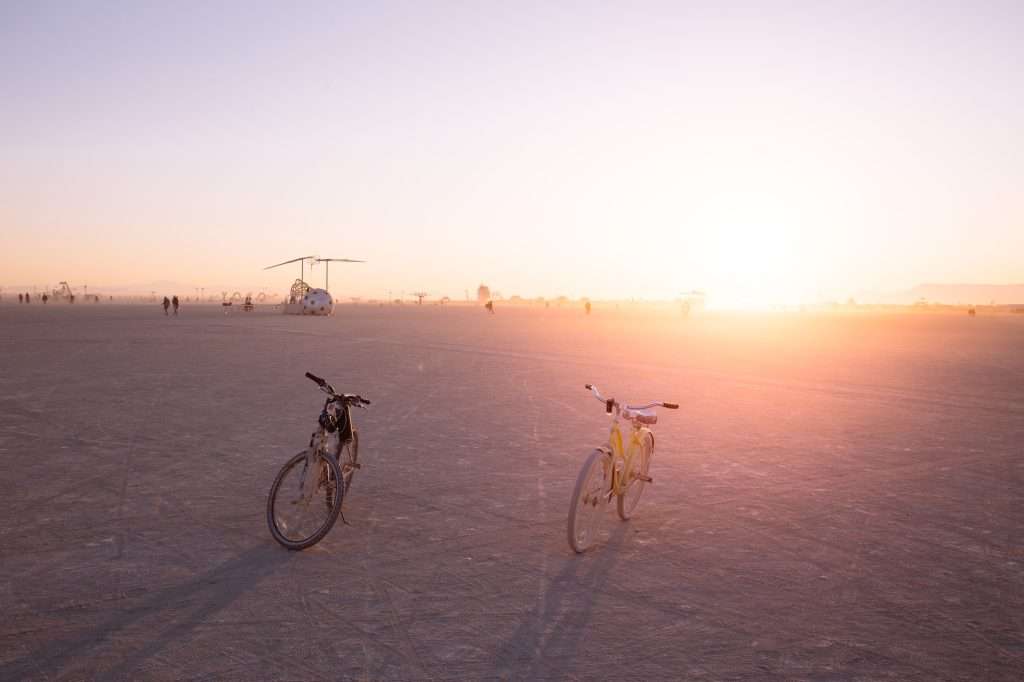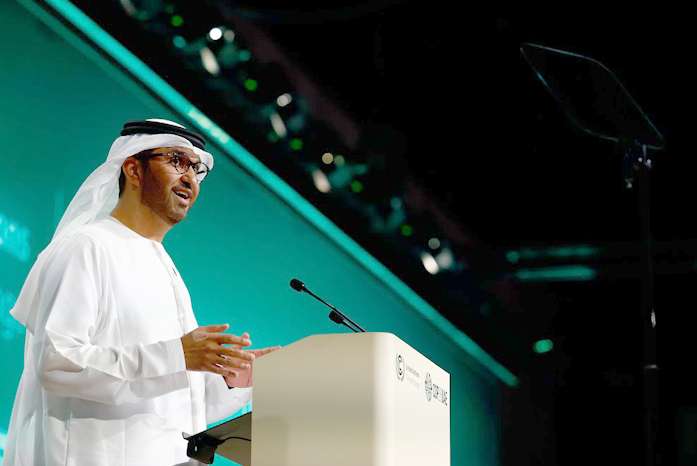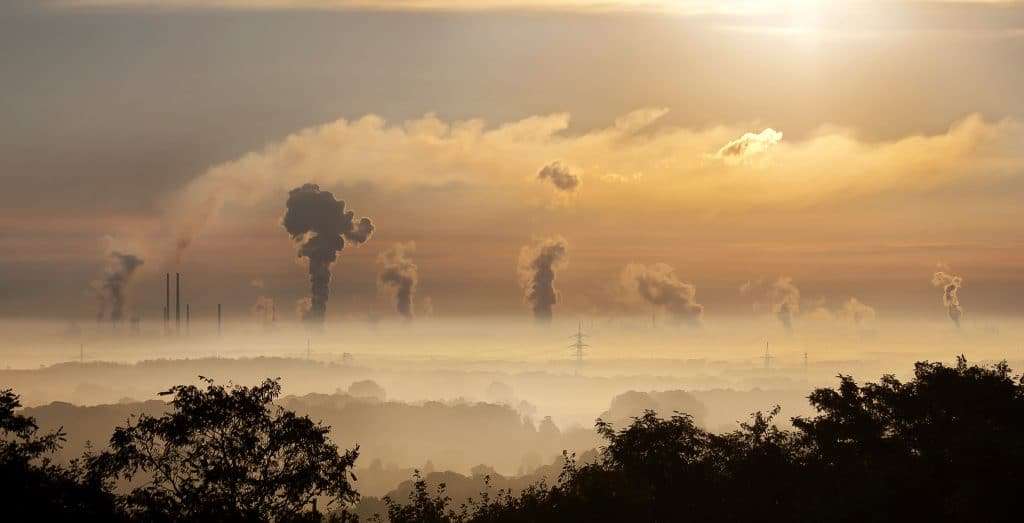As COP28 sees a record-breaking number of attendees all in the name of saving the planet, it’s starting to look a lot like something else.
For nearly four decades, thousands of mostly well-meaning (and mostly well-to-do) “burners” have gathered in a dried-out ancient lake bed in Nevada for the Burning Man festival that takes place over the week ahead of Labor Day.
Its founders, the late Larry Harvey and Jerry James, stalwarts of the Bay Area arts scene, began burning effigies (the “man”) on San Francisco area beaches in the late ‘80s before moving the festival a half-day’s drive east to Nevada’s Black Rock desert. Thousands of devotees and newbies alike now make the annual trek — an estimated 73,000 people attended Burning Man this year.
Burning Man’s calling card has long been that it brings a mix of mountain town hippies and Wall Street elite. It’s a favorite stomping ground of bare-chested Bay Area technocrat bros virtue signaling in cowboy hats while zooming around on $3,000 mountain bikes. Celebrities make the trek, too — everyone from Cher to Paris Hilton to Jeff Bezos and Elon Musk have been spotted out and about on the dusty playa. “If you haven’t been, you just don’t get it,” Musk told Recode in 2014.

The weeklong festival still leans heavily into its arts scene roots with creative theme camps, installations, art cars, the temple, and the ritual burning of the “man” on the festival’s last night. But it has also become a symbol of self-resilience and eschewing capitalism. For years, it was an assumption that if you cared about the future of humanity and the planet, you carved out that last week in August, loaded up a vehicle with a week’s worth of water, food, and glow sticks, and made the drive out past Reno to Black Rock City — Nevada’s second-largest city for seven days out of the year. Proving your self-reliance out there in the 100-degree arid desert was like throwing your own secret ingredient into a pot of “elevating the collective consciousness” soup — the end result better all because of you.
It’s not just a party, after all. During the day there are presentations and talks both public and covert on topics from investing to moving off-grid. You can spend time training with yogis and healers, or provide safe space for psychedelic users in need of support. You can earn your keep cooking, building, or, even, babysitting. But no one really comes just for that (even if they say they do). It’s the all-night drinking, drugs, and dancing, the (hopefully consensual) sex with strangers, and, these days more than ever, the reality TV-style TikTok footage.
While the event has long had an anti-corporate stance, brands routinely break the rules, sneaking in palettes of samples and swag to low-key market to unsuspecting burners out on the playa. Camps, too, have become sponsor-like opportunities for startups and incubators hoping to network into partnerships and funding opportunities. Popular natural soap company Dr. Bronner’s has been sending its employees to Burning Man for years, sometimes with a foaming shower experience. (But don’t call it a marketing opportunity.)
I attended Burning Man twice — first in 2007 when the event’s theme was Green Man, which put a focus on the connection and importance of nature; and again in 2012, when the theme was “Fertility 2.0” (and it’s possibly worth noting: my daughter was born a year later). As the end of the Mayan calendar neared in 2012 — a doomsday believer or not — there was a palpable sense among the “conscious” community that meeting out on that dusty playa that year was, if not the last opportunity to do so, at the very least, more critical than ever.
Except, of course, it wasn’t.
The world didn’t end, and certainly nothing any of us did or didn’t do out there in the desert had any influence on that outcome. Although, it does seem now that the world is indeed getting closer to the end as we know it, due in large part to our misuse of resources and lax accountability on curbing emissions. So, in that sense, I suppose, Burning Man is as much to blame as anything.

There’s irony though: Burning Man has long touted itself as an exercise in sustainability — the Blue Book example of a post-apocalyptic utopia. It’s preppers but with MDMA, electric bikes, and organic deodorant instead of religious zealotry, monster trucks, and firearms.
But this year marked a new chapter — quite possibly very near the final one: the playa was inundated with unprecedented storms — no doubt a result of climate change — that left people stranded, injured, and awash in three-eyed prehistoric shrimp (really!), that were awakened by the deep rains. For most attendees, it was all apocalypse, no utopia. Attendees, including celebrities like Chris Rock and DJ Diplo, ditched their belongings and fled to drier ground, leaving behind a soggy, muddy mess of trash — defying Burning Man’s long-standing bragging rights to being the world’s largest leave-no-trace event.
‘Burning Man 2023 is a climate-crisis parable’
Before the rain, in a script-worthy bit of foreshadowing as the festival got underway, climate activists blocked the entrance to the event delaying the already notoriously slow entry process. “[M]ore private jets than ever are flying to the Burn,” Tommy Diacono, co-founder of Rave Revolution, told The Guardian. “We’re burning propane for fun. The air-conditioned domes are getting bigger every year.”
While the event weathered back-to-back cancellations in 2020 and 2021 due to covid, its biggest challenge may be yet to come. “Burning Man 2023 is a climate-crisis parable,” read a Washington Post headline after this year’s event.
According to the 2020 sustainability report filed by Burning Man, more than 90 percent of the event’s carbon footprint comes from travel to and from the event. An additional five percent comes from the generators powering the all-night dance floors, the all-day air conditioning, stoves, lights, and the rest of it. According to Black Rock Labs, a non-profit tech incubator, the event produces about 100,000 tons of CO2 — roughly the same as operating 22,000 gas-powered vehicles for an entire year.

The event is taking steps to become carbon-negative by 2030 — a move that aligns with its leave-no-trave ethos. And it has made progress, namely by way of using solar energy to power camps; this year saw its biggest solar effort yet. But it may be a moot point as the storm festivalgoers saw this year could become the norm, experts warn, as could even more extreme temperatures than the 100-plus degree days in typical years. Climate experts say those temperatures could now regularly soar past 120°F making it dangerously inhospitable.
I found myself reflecting on all of this as my social media feeds became a frenzy of I’m-going-to-COP28 posts littered with exclamation points and emojis followed by ‘but seriously though’ rambles not unlike those that happen out on the playa when the moon and the drum-and-bass (and most of the attendees) are high.
Has the world’s biggest climate conference turned into Burning Man?
To be clear, COP28, the 2023 United Nations Climate Change Conference or Conference of the Parties of the UNFCCC, is not a festival; world leaders and key decision-makers attend the summit in earnest pursuit of solutions to slowing climate change. But as attendance has increased — COP24 in 2018 saw just 22,000 attendees, but this year will tip close to 100,000 — the number of significant commitments have dwindled.
Is COP28 really moving the needle on climate action?
The annual event’s biggest achievement to date, The Paris Accord, came in 2015 during COP21. (The Paris Accord or Paris Agreement is a global pact aimed at reducing greenhouse gas emissions and limiting global warming to well below 2°C above pre-industrial levels, with a further goal to limit the increase to 1.5°C.) But little at that scale has happened at the conferences since. Not unlike Burning Man, the bigger and more popular the annual COP conference has gotten, the more irreverent its outcomes seem to be. Its core focus is watered down — or rather, awash in a torrential storm of three-eyed corporate takeovers.
Here’s one critical example: COP28, which is happening in Dubai, will, for the first time in its history, host OPEC (The Organization of the Petroleum Exporting Countries). The organization aims to make the argument that renewable energy options, like wind turbines and solar panels, can’t exist without virgin fossil fuels. “Fibreglass, resin, and plastic are all petroleum-derived products,” reads a post on the OPEC website about its participation at COP28. “They are essential to the composition of a wind turbine and as of yet, cannot be substituted for this purpose at scale.”
That’s right, OPEC is making the argument that renewable energy can’t happen without digging up fossil fuels. There’s some truth to that, sort of, but it’s a bit like shaming a climate activist who’s having a heart attack for riding in a gas-powered ambulance instead of driving to the ER in an EV.
OPEC is there because of COP28 president, Sultan al-Jaber, who is also the CEO of the UAE’s national oil company ADNOC. Jaber used his COP28 opening remarks to suggest oil interests have a place in the climate fight — a move that aligns with accusations that he also used his position to pursue fossil fuel deals in meetings with governments (he denied the accusations).

The climate conference attendees will also see a notable presence from the meat and dairy industries even though the event’s menus are expected to be predominantly plant-forward for the first time. Animal agriculture is one of the biggest contributors to global warming — accounting for nearly 20 percent of global emissions — but animal ag representatives aim to make the case that animal products are both sustainable and nutritious solutions to the climate crisis. This comes amid accusations that the meat industry is paying “carnivore influencers” to lambast plant-based food as a climate and health solution.
Climate action is indeed paramount, and bringing key decision-makers together can bring solutions — or at least steps toward solutions. But COP28 faces pushback from major polluters like India, the third biggest emissions producer in the world. In October, Indian government officials said that the country is unlikely to sign onto a global pledge to reduce cooling-related emissions during the event, even though data continue to show we’re beyond a code red as global temperatures, extreme weather conditions, and natural disasters all increase. Deforestation, sea level rise, and biodiversity loss are already taking a toll on some of the world’s most vulnerable communities (not to mention the wars countless COP28 attendees flew over en route to Dubai).
There are positive expected outcomes at the summit, like the significant contributions made earlier this week to the “loss and damage” fund aimed at supporting low-income countries hit hardest by the climate crisis. Pledges include $100 million from the UAE, $51 million from Britain, $17.5 million from the U.S., $10 million from Japan, and $245.39 million from the E.U., which included $100 million pledged by Germany. The event is also aiming for a global stocktake, which will assess progress in meeting the Paris Agreement goal by individual country.

But are these wins being overshadowed by the summit’s SXSW-style spiral into hundreds of side events and the tens of thousands of bumptious “climate enthusiasts” flocking to Dubai? It’s looking a lot more like the increasing number of people who come to Burning Man in private jets and decked out RVs every year, just because they can. The shift to privileged playground has turned Burning Man into the antithesis of its gritty DIY art scene roots. “The ultra-wealthy have been known to fly in personal chefs for the week, and pay as much as $50,000 to camp in luxurious tents,” reports CNN.
Evolution happens, of course, but is the essence of Burning Man’s radical self-expression and self-reliance mantra really to be found in private jets, personal chefs, and 400 thread-count sheets? And can a climate event preoccupied with whos-who networking happy hours really bring meaningful commitments to reversing the climate crisis? Are the thousands of people who trekked to Dubai while chanting that familiar, self-important refrain, “but I have to go,” really fixing these problems? Could they better serve the cause by supporting their local communities, say, by, instead of spending 16 hours on a flight to Dubai, spending that much time cleaning up plastic from a local beach? Or, perhaps, planting trees, educating children, or sharing plant-based meals with people in need?
University College of London has created a calculator specifically for COP28 to help attendees measure their carbon footprint — most of which comes from international air travel. It offers a number of suggested offsets and other resources to help attendees feel better about making the trip. But its biggest benefit might just come from the singular question it asks before it lets you begin to input your data: “Do you really need to attend COP28 in person?”
Related on Ethos:


